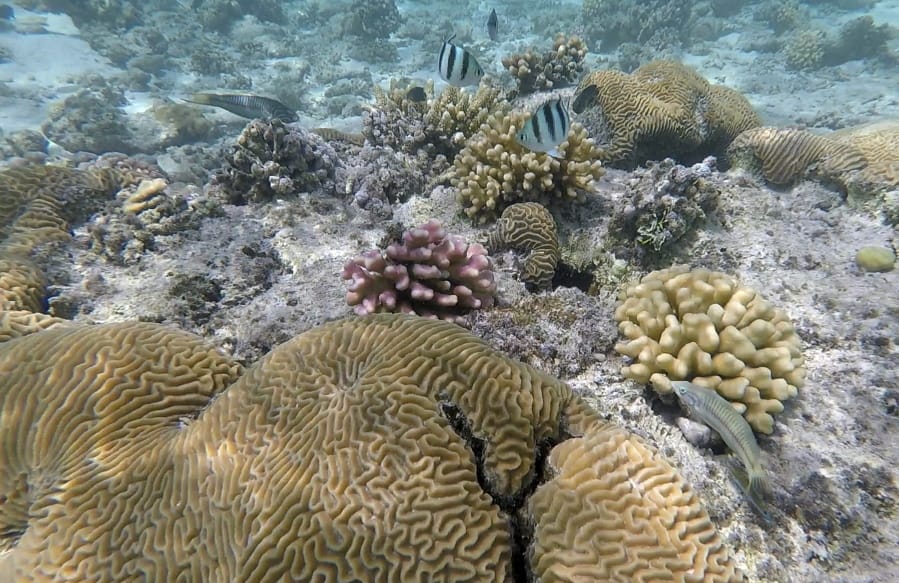OFF THE COAST OF JIDDAH, Saudi Arabia — The sky is clear, the sun is shining, and the sea is a glimmering turquoise. Nouf Alosaimi is on a discovery dive around a small, sandy island in the Red Sea that’s home to busy crabs and a few seagulls.
Jellyfish float near the edge of the boat in waters so translucent the fish are visible deep below. The 29-year-old Saudi woman is wearing a diving suit and a necklace with a silver charm in the shape of shark’s tooth, a nod to her nickname, “Sharky.” In the water, she wears a swim cap and dive suit. At sea, the sole woman diver among a group of men, she’s momentarily free from the edicts that govern life on shore.
Out here in the Red Sea, it’s easy to forget this is Saudi Arabia, a conservative Muslim country where the vast majority of women cover their hair and face with black veils, wear long, loose robes, known as abayas, in public, are largely segregated from men and cannot travel abroad without the permission of a male relative.
The serene waters north of the bustling city of Jiddah are the scene of a dramatic experiment to encourage tourism in the reserved and traditionally closed kingdom. It’s exciting for Alosaimi on multiple levels. It’s bringing new opportunities for women, as a corner of the country is carved out with somewhat relaxed rules. And it’s opening up miles of untouched coastline teeming with unexplored seascapes for her and other divers.
“We are here on an island in middle of the Red Sea. We want to discover this place,” Alosaimi said before her dive. “We may find this island beautiful for a picnic. We are creating a diving product here.”
Alosaimi, a PADI Master Scuba Diver Trainer, is a pioneer in her field, holding a local record for the deepest dive by a Saudi female at 345 feet. The technical dive required five tanks and lasted more than 70 minutes.
Her passion for diving takes her on an hourlong bus ride to work each day from Jiddah to King Abdullah Economic City. There, she works at a dive center recently opened at the Bay La Sun Marina and Yacht Club in preparation for the kingdom’s plans to open up to tourists later this year.
For decades, visitors to Saudi Arabia have largely either been pilgrims heading to Mecca and Medina or business travelers heading to the capital, Riyadh, or other major cities like Jiddah and Dammam.
Saudi Arabia’s 32-year-old heir to the throne, Crown Prince Mohammed bin Salman, is trying to change that with the introduction of tourist visas. It’s part of a much larger plan to overhaul the economy in the face of sustained lower oil prices. Tourism is being promoted as a way to create more jobs for Saudis, attract foreign investment, boost the economy and improve the country’s image abroad.
Tourism official Salah Altaleb said the country isn’t targeting mass tourism, but select tour groups interested in nature, diving, hiking and cultural sites.
“Saudi Arabia is a Muslim country that hosts the two holiest sites in Islam and these facts need to be respected whenever (tourists) travel around, enjoy themselves and engage with people,” he said.
The government’s sovereign wealth fund, which the crown prince oversees, has identified a 125-mile stretch of Red Sea coastline that it plans to transform into a global luxury travel destination with diving attractions and a nature reserve. The fund says the area will be a semi-autonomous destination “governed by laws on par with international standards,” suggesting veils and abayas won’t be required.
The Red Sea is also the site of an ambitious $500 billion project called “Neom” — an independent economic zone in a corner of the country near Egypt and Jordan that sits on 10,230 square miles of untouched land. Prince Mohammed has said he envisions it as a hub for technological innovation that will create jobs and attract investment.
Egyptian diver Tamer Nasr, who worked in Egypt’s Red Sea resort city of Sharm el-Sheikh for more than 20 years, said it could take divers years to map out Saudi Arabia’s nearly 1,200 miles of Red Sea coastline.



